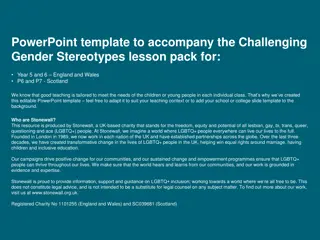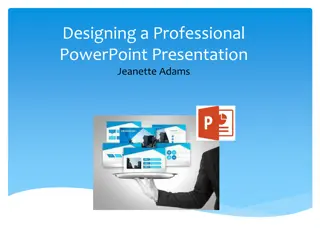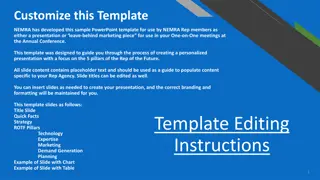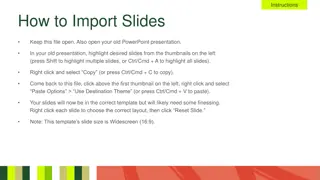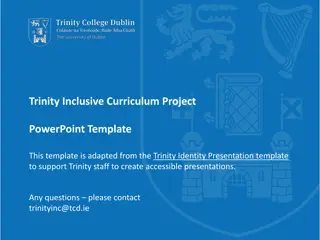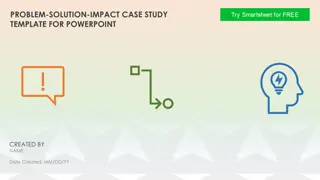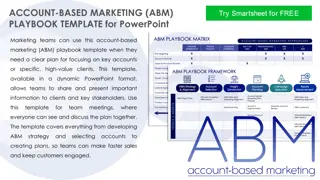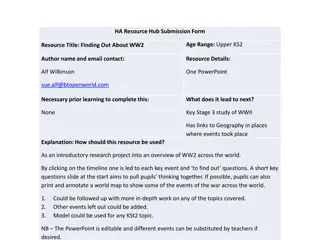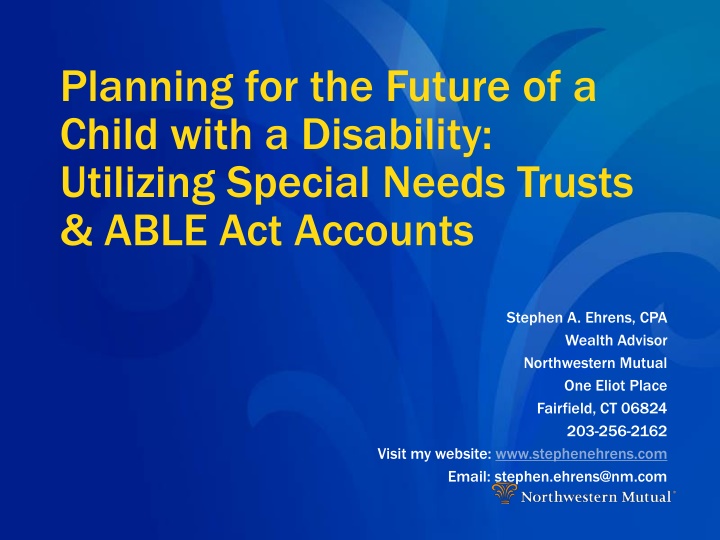
Planning for Future of Child with Disability: Special Needs Trusts & ABLE Act Accounts - Stephen A. Ehrens, CPA
"Discover how to plan for the future of a child with disabilities by utilizing special needs trusts and ABLE Act accounts. Address concerns, make difficult decisions, and follow a five-step planning process for long-term care and support. Get insights from Stephen A. Ehrens, CPA, on setting goals, assessing your situation, developing a plan, implementing it, and keeping it up-to-date."
Download Presentation

Please find below an Image/Link to download the presentation.
The content on the website is provided AS IS for your information and personal use only. It may not be sold, licensed, or shared on other websites without obtaining consent from the author. If you encounter any issues during the download, it is possible that the publisher has removed the file from their server.
You are allowed to download the files provided on this website for personal or commercial use, subject to the condition that they are used lawfully. All files are the property of their respective owners.
The content on the website is provided AS IS for your information and personal use only. It may not be sold, licensed, or shared on other websites without obtaining consent from the author.
E N D
Presentation Transcript
Planning for the Future of a Child with a Disability: Utilizing Special Needs Trusts & ABLE Act Accounts Stephen A. Ehrens, CPA Wealth Advisor Northwestern Mutual One Eliot Place Fairfield, CT 06824 203-256-2162 Visit my website: www.stephenehrens.com Email: stephen.ehrens@nm.com
My Familys Story: Elizabeth Ehrens In Vitro Baby 1.9 lbs and 12 inches at birth Severe speech apraxia (hard to understand) Learning Problems (at least 2 grade levels behind) Social problems How will she transition to a rich, productive and fulfilling life
Parent/Guardian Concerns Being outlived by his/her child Passing on too much responsibility to other family members Changes in state and federal laws and regulations Providing a lifetime of care and support for self and child
Difficult Decisions Who will be the legal guardian? Where will the child live? How will a lifetime of medical expenses be funded? How will the child s needs be fulfilled over time? How will the child be cared for as the parents age?
The Five-Step Planning Process Step One: Setting Goals Step Two: Assessing your current situation Step Three: Developing a plan Step Four: Implementing the plan Step Five: Keeping the plan up-to- date Flexibility is key to success!
Partnership for Planning Family Members/Care Givers Financial Professional Special Needs Financial Professional for Family Medical Professionals Social Workers Attorney CPA Public/Private Agencies
Public Benefits available at age 18 SSI-Supplemental Security Income -individuals with defined disability -Less then $2,000 in Assets for a Single Person -Max Monthly benefit of appox. $794 for 2021 -Non taxable benefit Medicaid-Less then $1600 to $2000 in Assets depending on State -Comprehensive benefits that include Medical, Medical equipment, Home care services, facility care, long term care, housing Local State/County/Non-Profit Agency Programs
Do you need a Third Party Special Needs Trust? Address the on-going and future needs of your child if you or a caregiver is unable to provide A means of protecting your child s assets and eligibility for government assistance-SSI and Medicaid The instrument is used to supplement benefits and provide for additional benefits Money may be Protected from Beneficiary- Creditors-Predators
How does it work? Can be funded currently or at death. ( Inter-Vivos vs. Testamentary Trust) 3rdparty trust funded with assets of anyone other than the beneficiary. (Parents and Grandparents) Can be funded with unlimited amount of assets-any type of assets Assets distributed by Trustee (s) Trust income may be taxed Distributions directly to goods and service providers, not directly to beneficiary No payback provision
Third Party Special Needs Trust Assets from a Special Needs Trust can be used to pay for amenities such as: Supplemental medical care Transportation Rehabilitation Education Entertainment Home Health aids Trips and vacations Computers and other equipment Avoid putting assets in the name of an individual with special needs!
ABLE Act Accounts Achieving a Better Life Experience Act Purpose is to encourage savings for Individuals with disabilities to maintain health, independence and quality of life Provide secure funding for expenses that will supplement benefits provided through private Insurance, SSI, Medicaid and other sources Individuals with disabilities have been limited to $2,000 in savings limits for program eligibility
Eligibility Account limits eligibility to individuals with significant disabilities with an age of onset prior to age 26 If you are receiving SSI or Medicaid you are automatically qualified If you meet Social Securities definition regarding Significant functional limitations If you receive a letter of certification from a licensed physician
ABLE Accounts State run by 529 plan sponsors-currently 39 states offering these accounts, more coming this year $15K annual contribution-Not tax deductible-May be some state income tax deductibility depending on state Accounts grow tax free-multiple investment options-fees vary Debit card may be available Max. account value of $100K. Max contribution varies by state. Once assets grow beyond this level, SSI is suspended Accounts not considered when determining eligibility for means tested programs which limit eligibility for individuals with over $2K in assets
ABLE Accounts Accounts used to pay expenses for individuals with disabilities and are program beneficiaries Money used for : Education, housing, transportation, personal support services, health and wellness, financial and legal, employment support, oversight, burial, etc. May be required to provide accounting to secretary of state Only 1 account per beneficiary Payback provision-Pay state back at death for aid provided to disabled individual
Significant Changes for 2018 Transfers from a 529 college savings account to an ABLE account are considered a qualified distribution, providing flexibility to move funds between programs without incurring any tax or penalty. The rollover can be in amounts up to the annual ABLE contribution limit of $15,000 Both accounts must have the same beneficiary. ABLE to Work Act: ABLE to Work Act: ABLE account beneficiaries who work will have an increased contribution limit starting in 2018, should they choose to contribute a portion of their earned income to their ABLE account. Additional $12,140 of earnings can be contributed.
The Letter of Intent A non-legal document consisting of the caregiver s intentions for the child Communicates the caregiver s intent and provides guidance to future caregivers It is important to keep this letter up to date!
Taxes and deductibility As a parent of a disabled child, if you itemize, you are entitled to deduct medical expenses, provided they alleviate your child s mental or physical condition Example: educational services, transportation, medical treatments and drugs All medical deductions must exceed 7.5% of your adjusted gross income
Diversify Your Assets Maximize the value of your estate! Real Estate Stock Market Business Insurance Lower Risk
Life Insurance is a solution: Provides lifetime income to dependents Provides estate tax liquidity Prevents forced sale of assets Allows for estate equalization Avoids probate Possible to avoid estate taxes on proceeds if held in a Trust
Life Insurance Protecting Your Earning Power Provides Survivor Benefits Cash value can be used for retirement Leverage of Life Insurance Easy to manage Death benefit Tax Free Can fund a Special Needs Trust for pennies on the dollar!
What are the Different Types of Life Insurance Term Insurance Permanent Insurance Permanent Insurance Whole Life Universal Life Variable Life Single Life Joint Life Cash value provides lots of flexibility
Different Ways to Fund Can fund over varying period of time-i.e.-lifetime, 10 years, 20 years, etc. Guarantees may exist within contract and are crucial to fully understand Risk-policy may not make it to death if not fully funded Who is managing investment of cash value within policy? Who takes risk?
The Application Process You must qualify! Exam blood, urine, EKG, blood pressure Application Personal History Interview (PHI) Doctors records Family History Medication Underwriting Standards point system
Annual Review of Insurance Is premium level or increasing? When does the term expire? Is death benefit guaranteed or projected? Is there enough cash in the policy to sustain it? Can the policy be replaced at a lower cost? In Force ledger should be In Force ledger should be requested annually requested annually
What Happens if the Child Does Not Need the Money? Create wealth for children by leaving a legacy Leave money to charity Pay taxes Takes pressure of existing assets that may be needed for retirement. Build cash value for supplemental retirement Accessing cash values for any purpose
Additional Risk Management Tools Disability Income Long-term Care Insurance Protects your ability to earn an income Reimburses costs for care (for chronic conditions) provided in: your home the community an alternate living facility a nursing home Replaces a portion of lost earned income due to a total or partial disability
Financial Strength Ratings of Insurance Companies Four (4) major rating services Moody's Standard & Poor's Fitch A.M. Best Company Check out the ratings for companies that you are considering Companies vary greatly; Find the one that is right for you.
Advantages of Starting Early Compounding Here are the monthly savings required at different ages to accumulate $1,000,000 by age 65, assuming an 8% compounded rate of return*: Monthly Investments Required to Reach Goal at Age 65* Age When Investments Begin 25 $ 285 35 667 45 1,686 55 5,430 The benefits of starting to save at an early age are clear! The benefits of starting to save at an early age are clear! * * Hypothetical example. For illustrative purposes only. This does not assume any particular investment strategy or product. No investment strategy can guarantee a profit or protect against a loss. Your results will vary from those shown as investing involves risk, fluctuation in returns, fees and charges. The data assumes reinvestment of all income and does not account for taxes or transaction costs.
My Dream for Elizabeth Living independently, but not alone Working in a fulfilling environment. Possibly a small business where she feels like she is making a major contribution Intellectually stimulated, through educational opportunities which may exist, so that she will be able to continue to grow Socially active, many friends and activities Ability to access all programs offered by all agencies
My Plan for Elizabeth - Ensuring her future Revised our Wills Designation of Executor-Trustee-Guardian Set up Special needs Trust to be funded at death Use of Letter of Intent-provides the details of Elizabeth s needs
My Plan for Elizabeth - Ensuring her future Diversification of all my assets to protect against market downturn Use of life insurance to provide for her once I am no longer here Opened an ABLE Account to fund her ongoing expenses in a tax efficient manner
My Plan for Elizabeth: Ensuring Her Future Use of disability insurance to continue to provide income if I were to become disabled Use of long term care insurance to protect against costs of nursing home and other care costs which could potentially deplete my assets
In Conclusion Establish a Special Needs Trust and Set up an Able Account Today! Ensures the maintenance of your child s quality of life and well-being with your directions and input Places your child s future in your hands Peace of Mind
Resources Resources Resources - - Please request via Email Please request via Email Beyond One day at a time-Trust guide Letter of intent Planning Check list Special Needs Data Taker Third Party resource overview Able Account resources Tax Guide National Care advisors-benefits consultants Power Point Presentation
Stephen A. Ehrens, CPA Wealth Advisor Northwestern Mutual One Eliot Place Fairfield, CT 06824 203-256-2162 Visit my website: www.stephenehrens.com Email: stephen.ehrens@nm.com Northwestern Mutual is the marketing name for The Northwestern Mutual Life Insurance Company, Milwaukee, WI (NM) (life and disability insurance, annuities) and its subsidiaries. Stephen Ehrens is an Insurance Agent of NM and Northwestern Long Term Care Insurance Company, Milwaukee, WI (long-term care insurance), a subsidiary of NM. Registered Representative and Investment Adviser Representative of Northwestern Mutual Investment Services, LLC (securities), a subsidiary of NM, broker-dealer, registered investment adviser, member FINRA and SIPC. There may be instances when this agent represents companies in addition to NM or its subsidiaries. Financial representatives do not provide legal or tax advice. Clients must seek advice regarding their particular circumstances from an independent advisor.

